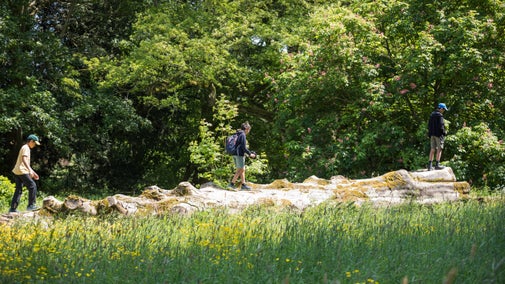
Discover more at Hatfield Forest
Find out when Hatfield Forest is open, how to get here, things to see and do and more.

Hatfield Forest National Nature Reserve is more than a medieval Royal hunting ground with ancient oaks and hornbeams. It’s also home to a vast array of wildlife, a range of special trees and archaeological remains from its 1,000-year history.
Immerse yourself in the beauty of the Forest with transformative experiences that restore balance and deepen your connection with nature.
Breathwork is a beautiful and powerful preventative tool that you can call on as part of a proactive approach to manage all aspects of your emotional health. We will use a variety of techniques to bring our bodies in to a parasympathetic “rest and digest “state, which will build up your baseline for managing stress, as well as increasing your emotion resilience; supporting your overall health and wellbeing.
This gentle yoga session is a good start your day with a relaxing way to enjoy the sights and sounds of early morning in the beautiful scenery of Hatfield Forest. Using a variety of techniques to manage stress, as well as supporting your overall health and wellbeing
Finished for the season.
"Shinrin-Yoku" or forest bathing is the practice of spending time in the forest for better health, happiness and a sense of calm. It literally means to bathe in the atmosphere of the forest, immersing your senses in your surroundings.
Finished for the season
Perfect for anyone that wants to work on their mind, body and soul by layering up healing modalities. We will combine breathwork and journaling to relax, release and restore.
Finished for the season
You might notice that Hatfield Forest looks a bit different to a modern forest. As a medieval forest, there is lots of open space mixed in with pockets of woodland or 'coppices' which are separted by grassy paths or 'rides'. Medieval forests were areas reserved for royal hunting, with specific laws to protect these rights, rather than areas full of trees.
Along with the ancient wood pasture, the forest layout and land use has not changed for the last 1,000 years.
At the centre of the Forest there is an ornamental lake about 300m long and covering about eight acres. This was formed in 1747 by damming a stream which ran through the forest. Today it's a peaceful spot to look for wildlife and take in the surroundings on a stroll.
There is also a smaller lake, known as the Decoy Lake, which becomes covered in water lilies in summer. This was originally part of the main lake and was built as part of a plan made in 1757 by the celebrated landscape designer, Lancelot 'Capability' Brown.
The open parkland by the lake has recently been restored to how it might have appeared about 1900, and, thanks to extensive scrub clearance, you can now see more trees and flowers, as well as better views of the lake.
In summer, take the opportunity to explore the lake by boat. Rowing boats are available for hire from the pontoon by the Shell House. This operates at weekends from the end of May, as well as everyday in the school holidays, (including the spring half term week 24 May to 1 Jun 2025), from 11.00am to 4.00pm. 5 max in a boat, £10 for 30 min, card only payment.
Hatfield Forest is a medieval forest, with native tree species such as oak and hornbeam. Many of these are ancient, with the oldest oak estimated to be well over 500 years old and having a huge circumference of 6.5 metres.
The lake is a great place to look for planes, horse chestnuts, sweet chestnuts, Scots pines, black pines, cedars, and even an apple tree. How many can you identify on your visit?

A lakeside picnic shelter was built by the Houblon family during the Georgian period. They would make excursions through the Forest to entertain their guests. The Houblons' teenage daughter Laetitia decorated the building with exotic shells, believed to have come from the West Indies. Look out for the shell peacock above the Shell House door. Its breast is made from a fossil from the Cretaceous period.
The Shell House went under much needed restoration work in 2023.
The Forest is a Site of Special Scientific Interest and a National Nature Reserve. The Forest's coppices and wood pasture are now extremely rare, providing a refuge for many unusual and specialised wildlife, including:
Buttercups - In May and June, the wood pastures are transformed into a golden sea of these loved wildflowers.
Fungi - Two very important species of fungi have recently turned up at Hatfield Forest. Neoboletus xanthopus and Inocybe cervicolor are so rare they had to be verified using DNA sampling. If you're exploring for fungi, please remember to leave them behind.
Butterflies - Thanks to coppice restoration and ride management, a growing number of butterfly species can be found in the forest. They include speckled wood, common blue, comma, ringlet, purple hairstreak and small tortoiseshell. Recent species rediscovered include the silver-washed fritillary, white admiral and purple emperor.
Beetles - The veteran trees and deadwood support many rare beetles, including lesser stag, rhinoceros and longhorn beetles. Hatfield Forest is in the top 10 sites in England for these deadwood specialists, so standing and fallen deadwood is kept in place wherever possible.
Dragonflies - These are commonly seen across the lake on warm summer days. Species include the large emperor dragonfly, southern hawker and other smaller damselflies.
Birds - The variety of habitats attracts many birds to the Forest. Resident species include tiny woodland birds such as linnets through to the swans on the lake. Look out for moorhen, robin, goldcrest, greenfinch, yellowhammer, reed warbler, mute swan, grebe, green woodpecker, greylag and Canada geese and sparrowhawk. Buzzards and red kites often soar over the open areas, hunting for prey.
Our flock of rare-breed sheep, including mainly Hebridean, plus some Manx and Jacob, are helping to transform overgrown bramble scrub into open wood pasture within several fenced enclosures. They can also be found grazing on the marshland habitats.
In the late spring and summer, the forest plays host to two herds of Red Poll cattle – docile, with no horns and said to be ‘the East Anglian Breed’. You may see them grazing, as part of the Forest's 1,000-year history of continuous management. By grazing the open plains and mature coppices, they prevent areas growing up into young woodland, keeping a balance of habitats.
Sheep and cattle have different grazing habits so make the perfect complementary team.

It's no surprise that an area as long associated with human activity as Hatfield Forest has many reminders of its past hidden in plain sight. See if you can find these archaeological remains as you explore.
The remains of a medieval rabbit warren, in the form of a series of ‘pillow’ mounds, can be found under the horse chestnut trees, south of Warren Cottage. Rabbits were introduced by the Normans and farmed for their meat and fur.
Portingbury Hills is an earthwork in Beggarshall Coppice, made up of three circular mounds. Recent research suggests that the surviving banks and ditches are medieval. Iron Age pottery found here may also indicate earlier occupation. The earthworks are best seen on very dry summer evenings when the light perfectly picks them out.
If you look carefully as you drive in through the first coppice, you can see the remains of concrete foundations and rusty legs of several huts. This part of the forest was used during the Second World War for the concealed storage of munitions for the nearby airfields.
This celebrated tree was one of the two stoutest trees ever measured in England, with a whopping circumference of 18.2m. It started to grow in about AD 950 and is mentioned in the Domesday Book. Leaves last grew in 1858, making it 908 years old when it died. Its location and circumference are marked with posts in hawthorn woodland just south of Elman's Green.
Does the Doodle Oak live on? A young oak tree, immediately north of the original Doodle Oak, is thought to have grown from an old root and has similar characteristics to its predecessor.

Find out when Hatfield Forest is open, how to get here, things to see and do and more.
Discover a range of outdoor activities at Hatfield Forest in Essex. From short to long walks, running routes, horse riding and fishing, there's something for everyone.

Hatfield Forest is a two pawprint rated place. It's a perfect place for walking your dog, with 1,000 acres of woodland and open grassland to explore, trees to sniff and grass to roll around in. Professional dog walkers will need a National Trust license to walk a maximum of 4 dogs, up to three times a day.

Hatfield Forest is home to an established population of both fallow and muntjac deer. Visit the coppices to see how many you can find.

The café at Hatfield Forest has views across the lake. You can also buy venison and firewood from the Estate Office when in season.

Learn about how the team at Hatfield Forest continue to look after this special place for everyone, for ever.

Plan a visit to one of the special countryside places in our care and discover the benefits of being in the great outdoors. Pack your walking boots and get ready to explore woodlands, valleys and rivers.

Explore some of the finest landscapes in our care on coastal paths, accessible trails, woodland walks and everything in between. Find the best places to walk near you.

Explore an ancient forest, acres of chalk grassland and other hidden countryside spaces around Essex, Bedfordshire and Hertfordshire.
